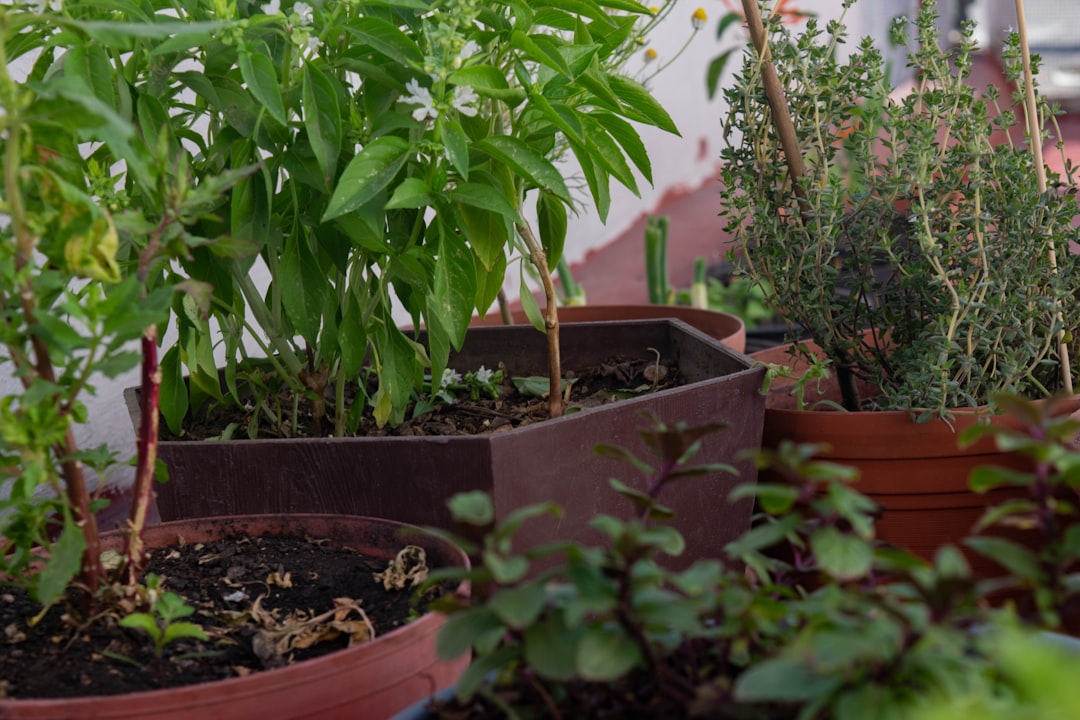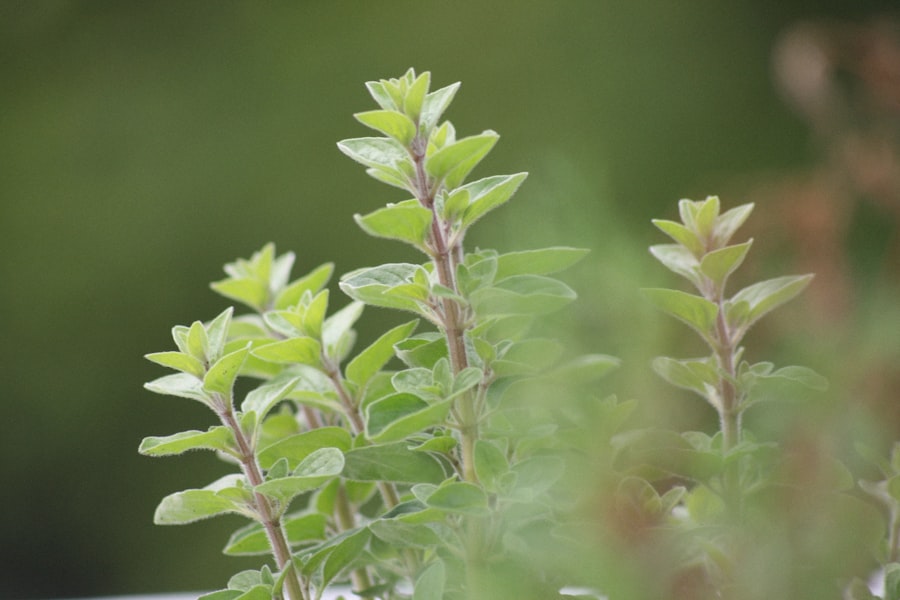Discovering Oregano: A Visual Guide to Its Appearance

Oregano is a versatile herb that has been used for centuries in both culinary and medicinal applications. It is a member of the mint family and is known for its strong, aromatic flavor. Oregano has a long history, dating back to ancient Greece and Rome, where it was used for its medicinal properties and as a culinary herb.
In culinary use, oregano is commonly used in Italian and Mediterranean cuisine. It adds a distinct flavor to dishes such as pizza, pasta sauces, and roasted vegetables. Oregano is also used in herbal teas and as a natural remedy for various ailments due to its antibacterial and antioxidant properties.
Key Takeaways
- Oregano is a popular herb known for its culinary and medicinal uses.
- Oregano is native to the Mediterranean region but can now be found in many parts of the world.
- Oregano has small, oval-shaped leaves that are green or grayish-green in color and a slightly hairy texture.
- There are several varieties of oregano, including Greek, Italian, and Mexican, each with their own unique flavor and aroma.
- Oregano can be grown in the wild or in a garden, and requires well-drained soil and plenty of sunlight for optimal growth.
Origins of Oregano: Where It Grows and Thrives
Oregano is native to the Mediterranean region, specifically Greece and Turkey. It thrives in warm, dry climates and is often found growing wild in rocky, well-drained soil. Oregano can also be cultivated in home gardens and is a popular herb to grow due to its hardiness and low maintenance requirements.
Ideal growing conditions for oregano include full sun exposure and well-drained soil. It can tolerate a wide range of soil types, but prefers slightly alkaline soil with a pH between 6.0 and 8.0. Oregano is drought-tolerant once established, but regular watering is necessary during dry periods to promote healthy growth.
The Anatomy of Oregano: Understanding Its Physical Characteristics
Understanding the anatomy of oregano plants is essential for successful cultivation and use. Oregano plants have a bushy growth habit, with multiple stems arising from the base. The stems are square-shaped and covered in small hairs.
The leaves of oregano plants are oval-shaped with a pointed tip. They are dark green in color and have a slightly fuzzy texture due to the presence of small hairs. The leaves are the most commonly used part of the plant and are harvested for culinary and medicinal purposes.
The Different Types of Oregano: Varieties and Their Unique Features
| Type of Oregano | Scientific Name | Flavor Profile | Unique Features |
|---|---|---|---|
| Mexican Oregano | Lippia graveolens | Strong, slightly citrusy | Not actually related to Mediterranean oregano; commonly used in Mexican and Latin American cuisine |
| Greek Oregano | Origanum vulgare subsp. hirtum | Robust, slightly bitter | Most commonly used in Mediterranean cuisine; high in essential oils |
| Italian Oregano | Origanum x majoricum | Mild, slightly sweet | Hybrid of Greek and Syrian oregano; commonly used in Italian cuisine |
| Syrian Oregano | Origanum syriacum | Spicy, pungent | Native to the Middle East; commonly used in Lebanese and Syrian cuisine |
There are several different varieties of oregano, each with its own unique features and characteristics. The most common variety is Origanum vulgare, also known as Greek oregano. It has a strong, spicy flavor and is often used in Mediterranean cuisine.
Another popular variety is Origanum majorana, also known as sweet marjoram. It has a milder flavor compared to Greek oregano and is often used in Italian dishes. Mexican oregano, or Lippia graveolens, has a citrusy flavor and is commonly used in Mexican and Latin American cuisine.
Oregano Leaves: Shape, Color, and Texture
Oregano leaves are oval-shaped with a pointed tip. They are dark green in color and have a slightly fuzzy texture due to the presence of small hairs. The leaves are the most commonly used part of the plant and are harvested for culinary and medicinal purposes.
The shape, color, and texture of oregano leaves can vary slightly depending on the variety. Greek oregano leaves are smaller and more narrow compared to other varieties. Mexican oregano leaves are larger and have a smoother texture.
The characteristics of oregano leaves are important for identification purposes and for culinary use. The strong flavor of oregano comes from the essential oils present in the leaves, so it is important to choose leaves that are fresh and aromatic for the best flavor.
Oregano Flowers: Appearance and Bloom Time

Oregano flowers are small and tubular in shape, with petals that range in color from white to pink or purple. They grow in clusters at the top of the stems and bloom from late spring to early summer.
The bloom time of oregano flowers is important for pollinators, as they provide a valuable source of nectar and pollen. Bees and butterflies are attracted to the flowers and play a crucial role in pollinating the plants.
Oregano Stems: Size, Shape, and Strength
Oregano stems are square-shaped and covered in small hairs. They arise from the base of the plant and can grow up to 2 feet tall. The stems are sturdy and provide support for the leaves and flowers.
The size, shape, and strength of oregano stems are important for plant health and culinary use. Sturdy stems are less likely to break or bend under the weight of the leaves and flowers. When harvesting oregano, it is important to cut the stems close to the base to encourage new growth.
Oregano Seeds: Size, Shape, and Germination
Oregano seeds are small and oval-shaped, with a dark brown color. They are typically harvested from mature plants in late summer or early fall. Oregano seeds have a hard outer shell that needs to be scarified or stratified before planting to improve germination rates.
The germination process for oregano seeds can take anywhere from 7 to 14 days. It is best to start seeds indoors in pots or trays filled with well-drained soil. Once the seedlings have developed a few sets of true leaves, they can be transplanted into the garden.
Oregano in the Wild: Observing Its Growth and Habitat
In the wild, oregano can be found growing in rocky, well-drained soil in Mediterranean regions. It is often found growing alongside other herbs such as thyme and rosemary. Oregano is a hardy plant that can tolerate harsh conditions such as drought and poor soil quality.
Oregano plants in the wild have a bushy growth habit, with multiple stems arising from the base. They can grow up to 2 feet tall and produce clusters of small, tubular flowers. Oregano plants in the wild provide a valuable source of food and habitat for pollinators such as bees and butterflies.
Oregano in the Garden: Tips for Growing and Cultivating This Herb
Oregano is a popular herb to grow in home gardens due to its hardiness and low maintenance requirements. It can be grown from seeds or transplants and thrives in full sun exposure and well-drained soil.
To grow oregano in the garden, it is best to start with healthy transplants or seeds. Plant them in well-drained soil and water regularly until they are established. Oregano plants do not require much fertilizer, but a light application of compost or organic fertilizer can help promote healthy growth.
Regular pruning is important for maintaining the shape and health of oregano plants. Harvesting the leaves regularly will also encourage new growth and prevent the plant from becoming woody.
Understanding the anatomy and characteristics of oregano is essential for successful cultivation and use in culinary and medicinal applications. Oregano has a long history and is valued for its strong, aromatic flavor and medicinal properties.
Oregano is native to the Mediterranean region and thrives in warm, dry climates. It can be grown in home gardens with full sun exposure and well-drained soil. The leaves, flowers, stems, and seeds of oregano all have unique characteristics that are important for identification and culinary use.
By understanding the anatomy of oregano plants, gardeners can successfully cultivate this versatile herb and enjoy its flavorful leaves in a variety of dishes. Whether used fresh or dried, oregano adds a distinct flavor to many cuisines around the world. Additionally, oregano has been used for centuries as a natural remedy for various ailments due to its antibacterial and antioxidant properties.
If you’re curious about what the oregano plant looks like, you might find this article on Lawn World’s website interesting. They have a comprehensive sitemap that includes a variety of gardening topics, including information on different types of plants. One of their articles specifically focuses on oregano plants and provides detailed descriptions and images to help you identify this aromatic herb. Check it out here to learn more about the appearance of the oregano plant.
FAQs
What is an oregano plant?
An oregano plant is a perennial herb that belongs to the mint family. It is commonly used as a culinary herb and has medicinal properties.
What does an oregano plant look like?
An oregano plant has small, oval-shaped leaves that are dark green in color. The leaves are about 1-2 inches long and have a slightly fuzzy texture. The plant can grow up to 2 feet tall and has small white or pink flowers.
Where is the oregano plant commonly found?
The oregano plant is native to the Mediterranean region but is now widely cultivated in many parts of the world. It can be found in gardens, farms, and in the wild.
What are the uses of the oregano plant?
The oregano plant is commonly used as a culinary herb in many dishes, especially in Italian and Mediterranean cuisine. It is also used in traditional medicine to treat various ailments such as respiratory infections, digestive problems, and menstrual cramps.
How do you grow an oregano plant?
An oregano plant can be grown from seeds or cuttings. It prefers well-drained soil and full sun exposure. It can be grown in pots or in the ground and requires regular watering and pruning to maintain its shape and size.



